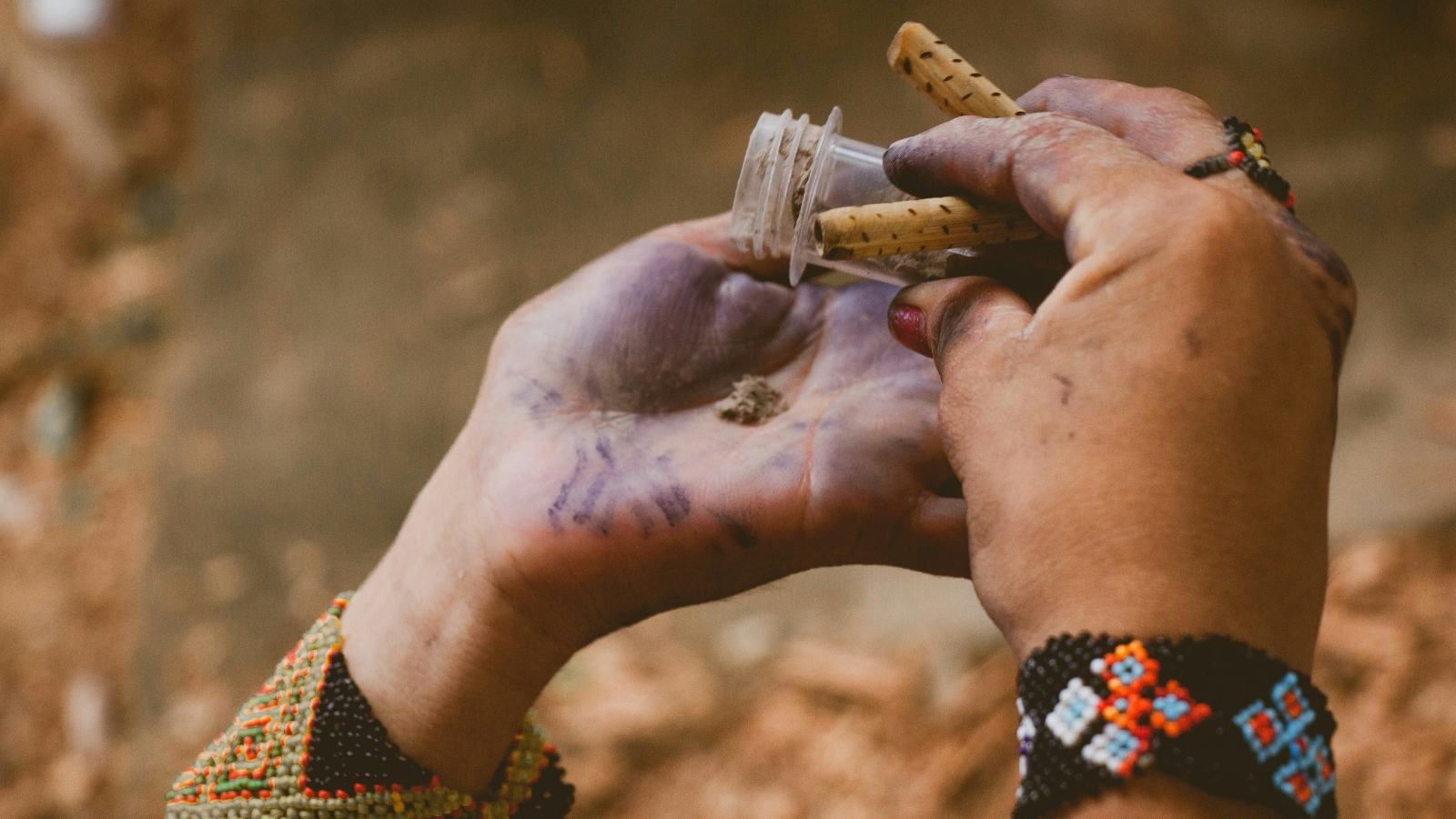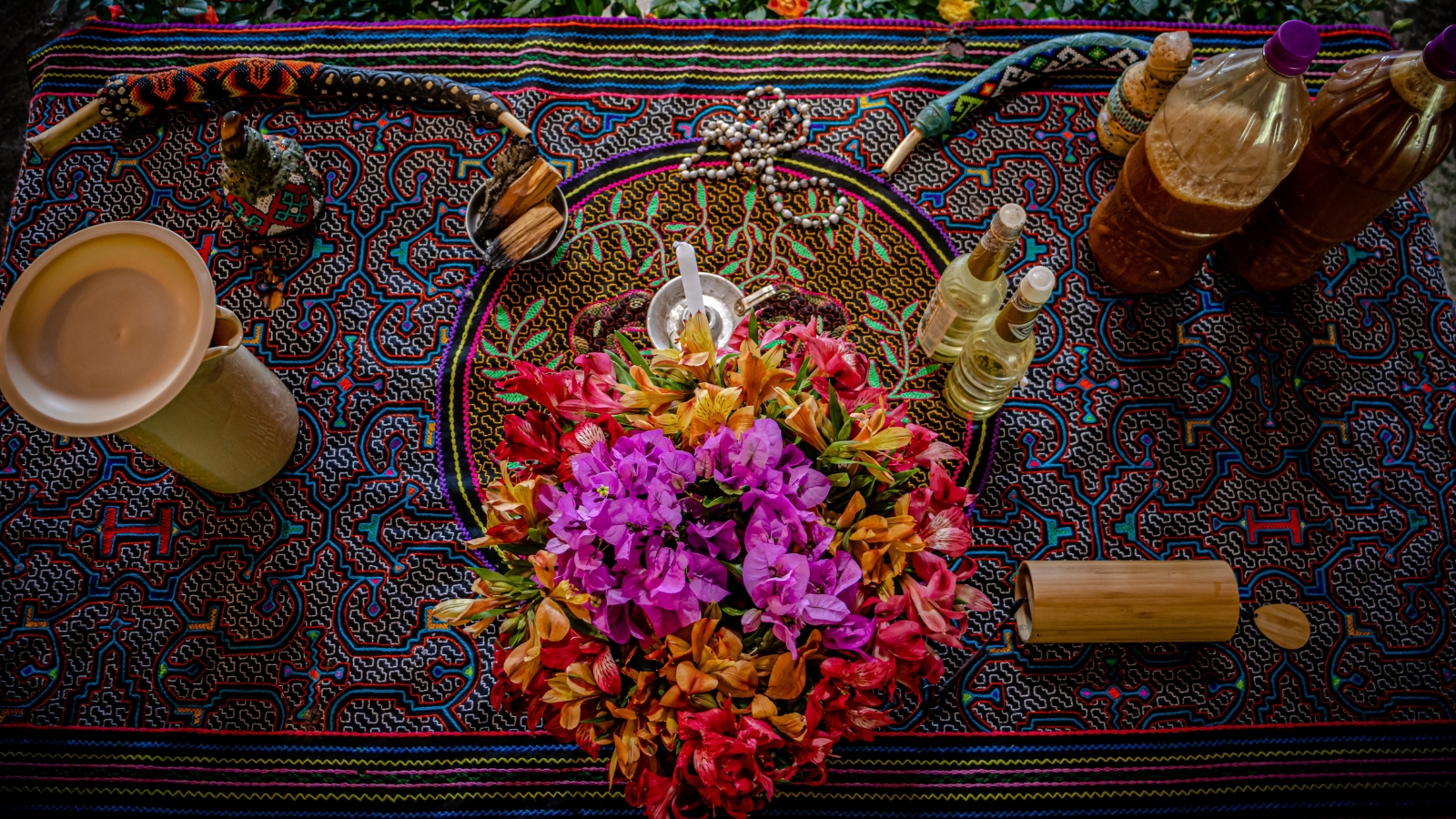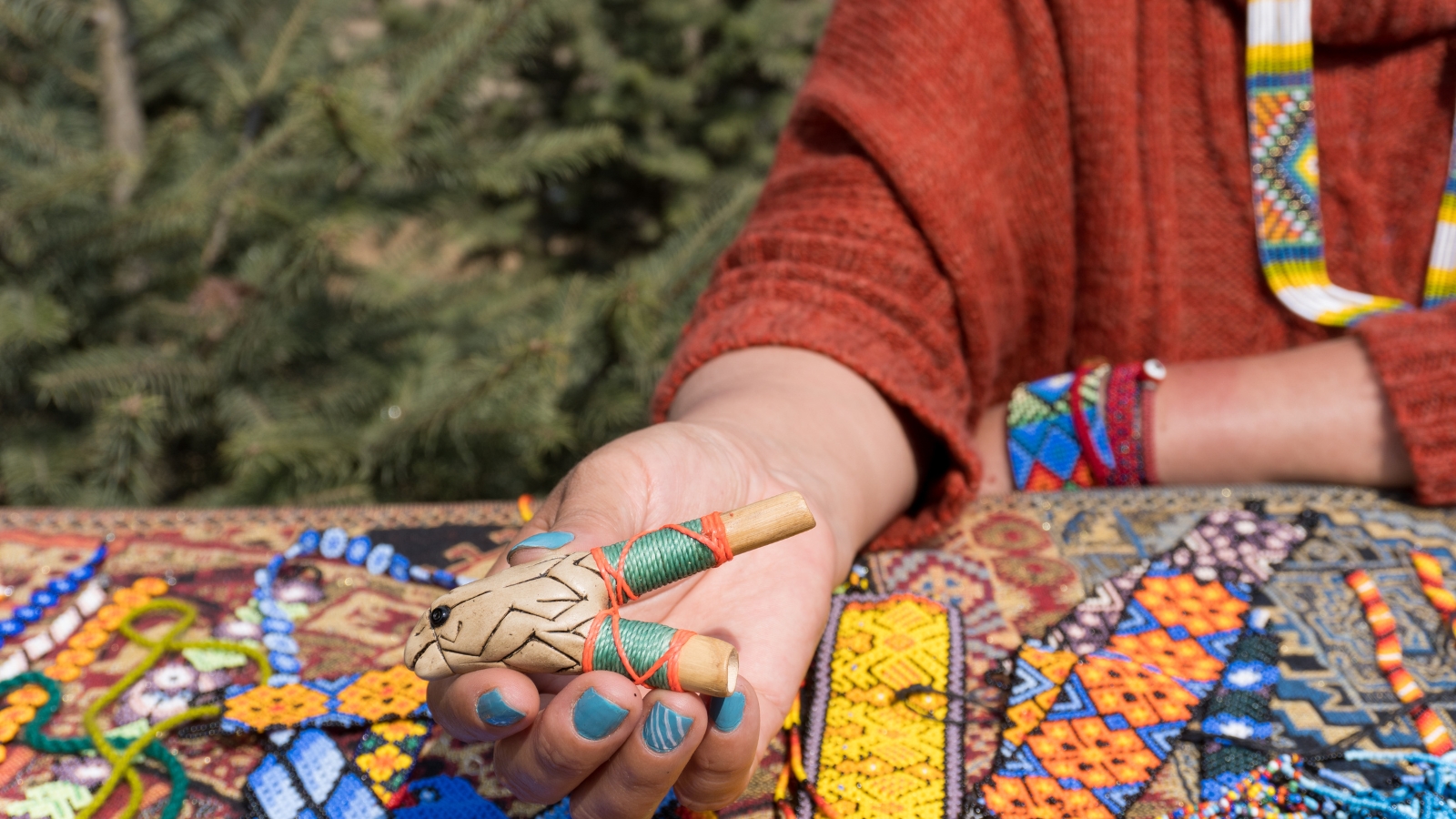Intention: To learn about the ancient and spiritual use of ceremonial snuff, and understand how to incorporate it into ritual practices.
In today’s world, there’s a growing fascination with practices that bridge the gap between the spiritual and the tangible. One such tradition, which has been quietly weaving its way through spiritual communities worldwide, is the use of Hapé (pronounced “ha-peh”), a sacred shamanic snuff deeply rooted in the indigenous cultures of the Amazon.
This finely ground powder, revered for its ability to purify the body and sharpen the mind, offers a unique window into the sacred rituals and profound wisdom of Amazonian tribes.
For centuries, Hapé has been a cornerstone of spiritual ceremonies, used by shamans and healers to connect with the divine, cleanse the spirit, and prepare the body and mind for deep meditative practices. Unlike many modern substances used for similar purposes, Hapé stands out for its rich cultural heritage, natural composition, and multifaceted benefits that span the physical, mental, and spiritual realms.

What Is Hapé?
Hapé is not merely a substance but a sacred tradition. It is a finely milled powder that serves as a bridge between the spiritual and the physical, connecting users to the ancient wisdom of the Amazon. This shamanic snuff, primarily crafted from the leaves of Nicotiana rustica, a potent variety of tobacco known as mapacho, is revered for its robust nicotine content and profound spiritual significance.
However, Hapé’s composition transcends this singular ingredient, incorporating a symphony of medicinal herbs, tree ashes, and other natural elements, each blend carrying its unique signature, purpose, and strength.
The preparation of Hapé is as much an art form as it is a science, handed down through generations of tribal shamans. These custodians of tradition meticulously select, dry, and grind the components into a fine powder. The process is imbued with ritual and reverence, ensuring that each batch of Hapé is more than just a mixture of ingredients—it’s a living, breathing entity, endowed with the spirits of the plants from which it’s made. This sacred powder is used in a variety of contexts, from individual meditation and purification rituals to communal ceremonies that strengthen bonds and facilitate healing.
The Spiritual and Physical Impact of Hapé
Unlike the recreational use of tobacco in Western culture, Hapé’s role in Amazonian societies is deeply integrated into the fabric of spiritual life. It is a tool for cleansing not just the body, but the spirit, offering clarity, protection, and connection to the natural world.
Administered through the nose using specialized pipes—Tepi for communal use or Kuripe for personal application—the powder bypasses the blood-brain barrier. This direct delivery system ensures that its effects are felt swiftly and intensely, facilitating a profound experience that can vary from a heightened state of alertness and focus to deep, introspective journeys.
Hapé’s effects, while physical in nature, are fundamentally spiritual. Users report a wide array of experiences, from visceral sensations of warmth and tingling to emotional releases and epiphanies. These experiences are not only deeply personal but are also shaped by the specific blend of Hapé, the setting of the ceremony, and the intentions set by the user and the facilitator.
In this way, Hapé acts as a catalyst for transformation, a tool for inner exploration, and a means of reconnection with the ancient wisdom that guides us toward harmony with ourselves and the world around us.
Other Names for Hapé
Hapé is known by various names that reflect the cultural and linguistic diversity of its users. Rapé, Rapeh, and Hapéh are common variations, each tied to different indigenous groups and their unique traditions.
For instance, the Katukina tribe refers to it in their dialect, which might differ significantly from the Yawanawá’s term, Nëpowë. These names not only denote the substance but often hint at the specific ingredients and rituals associated with its use.
Understanding these names is crucial for those interested in Hapé, whether for research, spiritual exploration, or sourcing authentic blends. Different names can guide one to discover the substance’s origins, revealing the specific traditions and intentions behind each variant. This knowledge is invaluable for ensuring authenticity and for gaining insights into the varied ceremonial practices involving Hapé.

Historical Background
Hapé has a deep background. Understanding the historical and cultural context is vital when using substances.
Origins in Amazonian Tribes
The roots of Hapé stretch deep into the heart of the Amazon, where it has been an integral part of indigenous life for centuries. Originating from the rich biodiversity of the rainforest, Hapé is more than just a traditional substance; it embodies the connection between the people and their sacred land.
Amazonian tribes such as the Katukina, Yawanawá, and Nukini have long used Hapé in their rituals, viewing it as a powerful means to communicate with the spiritual realm. These tribes have developed and preserved the recipes and rituals surrounding Hapé, passing down this sacred knowledge through generations.
Use in Ancient Ceremonies and Modern Practices
Traditionally, Hapé was used in rites of passage, healing ceremonies, and other significant tribal gatherings. It served to align the participants with their spiritual guides, cleanse their energies, and prepare them for the challenges or transitions ahead.
In today’s world, Hapé has found a place within the broader context of spiritual practices, embraced by a global community seeking to reconnect with ancient wisdom. While its use has spread beyond the Amazon, the essence of Hapé remains deeply rooted in the intention of fostering connection, healing, and spiritual awakening.
The Spiritual and Medicinal Uses of Hapé
The situations in which one might use Hapé are fairly specific, but there are a multitude of reasons why someone may choose to work with this medicine.
Spiritual Purification and Connection
At its core, Hapé is a tool for spiritual purification, enabling individuals to clear negative energies and realign with their higher selves. The act of administering Hapé is often accompanied by specific prayers or intentions, focusing the mind and spirit on the desired outcomes of the ceremony. This practice facilitates a profound sense of connection to the Earth, the spirit world, and the deeper aspects of the self, serving as a bridge to the sacred.
Medicinal Benefits: Mental Clarity, Physical Detox, and More
Beyond its spiritual applications, Hapé is revered for its medicinal properties. The nicotine-rich mapacho at its base is a potent purgative, encouraging the release of both physical and emotional toxins. Users often report enhanced mental clarity, focus, and an overall sense of well-being following its use. These effects are attributed not only to the tobacco but also to the various medicinal plants each blend contains, offering a holistic approach to healing.
Integration into Other Ceremonial Practices
Hapé is frequently used in conjunction with other ceremonial substances such as ayahuasca. Many indigenous cultures believe that ayahuasca is imbued with feminine energy. This is a common theme for many people who drink this brew, and it’s largely agreed upon that “mother” or “grandmother” ayahuasca is deeply feminine.
On the other hand, Hapé is generally considered to embody masculine energy. Its grounding effects are said to complement the visionary nature of ayahuasca, providing balance and stability in the midst of profound spiritual exploration. This synergy highlights the deep understanding indigenous cultures have of the natural world’s healing powers. The marriage of the feminine and masculine in ritual ceremonies offers valuable insights for those on a path of personal and spiritual development.

How to Use Hapé with a Kuripe
Used in ceremonies involving two or more people, the Tepi is a long, usually bamboo or bone, blowpipe. It allows one person to blow the Hapé into the nostrils of another, facilitating a shared experience and the transfer of energy from the administrator to the recipient.
For self-administration, the Kuripe, a V-shaped pipe, enables individuals to self-apply Hapé. This practice supports personal meditation and intention-setting, allowing for a deeply personal experience with the medicine. You can often find them in a set.
Here is a step-by-step for using the Kuripe, which will also help anyone be prepared to use a Tepi with another person.
1. Preparation
Begin by finding a quiet, comfortable space where you can sit undisturbed. This setting is crucial as it contributes to the effectiveness of your experience. Ensure the area feels sacred and safe to you. Some people choose to light a candle or incense to create a serene atmosphere.
2. Setting Intentions
Before starting, take a few deep breaths to center yourself. Reflect on your intention for this ceremony. Are you seeking clarity, grounding, or perhaps a release of specific energies? Hold this intention in your mind as you prepare to administer the Hapé.
3. Handling the Hapé
With your intention set, carefully take a small amount of Hapé and place it on the back of your hand or a small dish. The amount typically resembles the size of a pea, but you may adjust based on your experience and tolerance.
4. Filling the Kuripe
Using a small stick or the scoop end of the Kuripe, carefully transfer the Hapé to the V-shaped end of the pipe. Gently tap the Kuripe to settle the Hapé without compacting it too tightly, ensuring it can be easily inhaled.
5. Positioning the Kuripe
Hold the Kuripe with one hand, positioning the shorter end just outside one nostril, ensuring a comfortable but secure fit. Seal the other nostril with your free hand. Historically, the initial use of Hapé is administered into the left nostril, a practice seen as symbolic of eliminating negative energies. Following this, a subsequent dose is applied to the right nostril, this time symbolizing the ushering in of positive transformations.
6. Blowing the Hapé
Take a deep breath and hold it. Then, position the appropriate ends of the pipe snugly against the left nostril and the lips. With the eyes closed, slowly and gently breathe out, propelling the Hapé from the pipe’s hollow, V-shaped bend directly into the nasal passage. When done with care, this method is often described as inducing a calming sensation, accompanied by a mild, fleeting sting reminiscent of pepper.
7. Receiving the Hapé
Once inhaled, gently remove the Kuripe and close your eyes, focusing on your intention. You may feel an immediate sensation—warmth, tingling, or a strong urge to sneeze or blow your nose. Allow these sensations to pass, maintaining your focus on the intention and the breath. Keep some tissues on hand, as you may feel the need to blow your nose a few times.
8. Repeating for the Other Nostril
After a moment of absorption and reflection, repeat the process for the other nostril. This bilateral application is essential for balance and full reception of the Hapé’s effects.
9. Meditating and Reflecting
Once both nostrils have received Hapé, sit quietly, breathing gently through your mouth, and meditate on your intention. The effects can be immediate and profound. Allow yourself to feel whatever arises, be it emotional release, clarity of thought, or a deep sense of connection.
10. Closing the Ceremony
After spending some time in meditation and reflection, when you feel the process is complete, express gratitude for the medicine and any insights received. This can be an internal acknowledgment or spoken aloud. Gently bring yourself back to your surroundings, moving slowly as you may feel light or sensitive after the ceremony.
What Does Hapé Feel Like?
For some folks, the sensation of using Hapé is often vividly described as akin to having chlorine forcefully blown up one’s nose—a comparison that highlights the intensity and, for some, the initial discomfort of the experience. Others describe it as “lighting” spreading across the brain.
This initial sensation can be quite harsh and far from pleasant. However, the intense feelings or the rush often associated with Hapé are fleeting, typically lasting only between five to ten minutes. It’s not an extended period of altered state but rather a brief journey.
Many liken the aftermath, the feeling of being deeply grounded, to the sensations you get after spending 20 to 30 minutes in a sauna. There’s a certain euphoria that envelops you, encouraging a desire to simply relax deeply into your surroundings.
Despite the initial harshness that might make the experience seem daunting, it culminates in a state that is quite the opposite—pleasant and euphoric. This juxtaposition of discomfort followed by a profound sense of well-being and groundedness is what makes the experience uniquely compelling.

Safety and Considerations
Due to its direct impact on the body and spirit, newcomers should start with smaller doses under the guidance of an experienced practitioner, allowing their bodies and spirits to acclimate to its effects.
While Hapé is natural, its powerful effects, particularly due to the presence of nicotine and other potent compounds, can pose risks. Overuse can lead to nicotine overload, characterized by nausea, dizziness, or headache. Even in smaller doses, it’s not uncommon to feel nauseous, and even vomit.
To mitigate these risks, it’s important to use Hapé in moderation, listen to your body’s reactions, and ensure there is an adequate interval between sessions. Individuals with respiratory issues or sensitivity to tobacco should proceed with caution.
Ethically, it’s important to honor the sacred origin of Hapé, acknowledging its cultural significance and ensuring respectful use.

Finding and Choosing Hapé
Authentic Hapé comes directly from indigenous tribes or trusted suppliers who work ethically with these communities. Given the rise in global demand, it’s vital to research suppliers to ensure the Hapé’s authenticity and quality. Genuine Hapé is prepared using traditional methods, with respect for the plants and people from whom it originates.
Importance of Ethical and Sustainable Sourcing
Ethical sourcing ensures that indigenous communities are fairly compensated for their knowledge and products, supporting their livelihoods and culture. Sustainable sourcing practices ensure that natural resources are harvested responsibly, preserving the biodiversity of the Amazon and the spiritual integrity of the Hapé.
Different Blends and Their Purposes
There are numerous Hapé blends, each with specific intentions and effects, ranging from grounding and healing to enhancing meditation and spiritual insights. The choice of blend should align with your intentions and needs. Familiarizing yourself with the properties of different plants and ashes used can help you select a blend that resonates with your spiritual and medicinal goals.
Final Thoughts
This sacred snuff not only cleanses the body and spirit but also connects us to the earth’s ancient wisdom. Approaching Hapé with respect and intention while prioritizing ethical sourcing supports indigenous practices and ensures the tradition’s integrity.
Hapé’s potent effects demand mindful engagement, emphasizing safety and reverence. Whether explored alone or in shared ceremonies, it promises a path to clarity, healing, and spiritual grounding. By incorporating Hapé into our spiritual practices, we embrace a powerful tool for transformation, fostering a deeper connection with ourselves and the world around us.















